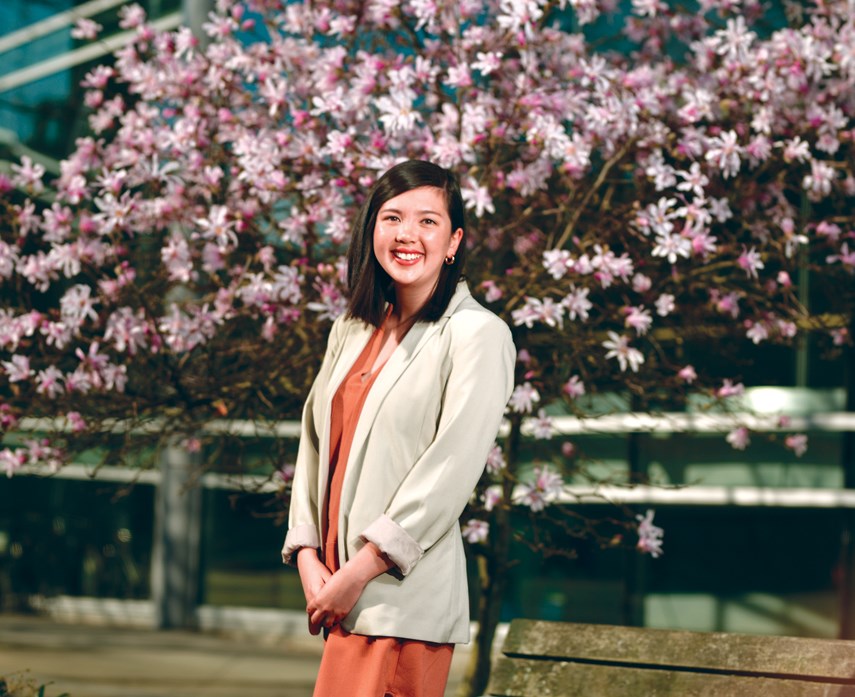She was a patient without a diagnosis.
From the spring of 2016 to that winter, Emily Chan bounced from the neurology department to the psychiatric department and back again as health-care professionals applied the right cure to the wrong disease.
Having recently graduated from the University of Ottawa, Chan settled with her parents in North Vancouver as she began her career. She was happy and healthy. But just two months after starting her job handling communications for environmental non-profit Ecojustice, she couldn’t sleep.
She must have slept – a few minutes here, a couple winks there. But that’s not how it felt, she remembers.
She took melatonin and exercised. She put plugs in her ears and a sleep mask over her eyes. She hid her phone away and stopped reading in bed.
And still her insomnia worsened for three weeks until she had a grand mal seizure.
“Those were the first signs that there was something really wrong,” Chan recalls.
But figuring out what was wrong was a challenge.
“I started getting sick during a time when there were so many changes happening in my life so at first it did seem like the simplest explanation was that I was stressed out,” she says. “I was more confused, more forgetful. I was still functioning at work but things were definitely starting to get more difficult.”
After being put into an induced coma, Chan was discharged from Lions Gate Hospital and started seeing a psychiatrist.
“But things were continually getting worse,” she says.
Her anxiety worsened to the point where she thought people on the street were watching her. Sometimes she thought they could hear her thoughts. There were unsettling dreams and even hallucinations.
“I could feel all the time that something was really wrong,” she says.
She stopped working. As a patient without a diagnosis, Chan could have slipped through the cracks.
“I’m so fortunate my parents were there,” she says. “They could think clearly and look at me and say: ‘This is not Emily.’”
Her mother, Sally Chan, teaches kindergarten at Queensbury Elementary. Her father, Rick Chan, is principal at Eastview Elementary.
As summer turned to fall they watched their daughter’s condition worsen and knew the doctor’s theory about stress was, if not entirely wrong, at least incomplete.
“At that point the theory was that everything that was happening was stress-induced.”
She saw a psychiatrist throughout the summer. It didn’t help.
She struggled to sleep. Her anxiety and mood swings worsened, along with vivid dreams.
“I now realize I was starting to hallucinate,” she says. “I knew something was really wrong.
Chan went to a different psychiatrist who, to his credit, realized Chan’s problem’s weren’t psychiatric. Theorizing that the seizures and other symptoms weren’t a coincidence, he sent Chan to a neurologist who ordered a battery of tests.
Following a lumbar puncture, Chan got her diagnosis and was admitted to Vancouver General Hospital.
“That is where I received the treatment that I would say saved my life,” she says.
Chan doesn’t remember the moment she got her diagnosis.
By that point she’d been through a battery of tests and departments and sessions all while something that no one seemed able to name took her further from who she knew she was.
It wasn’t stress.
The name for what she had was Anti-NMDA receptor encephalitis, or ANMDARE. Chan didn’t know what it was but she knew what it meant to hear the words.

She’s told that in that moment she turned to her mother. Her expression was “sort of confused, sort of in disbelief,” and she asked the question she hadn’t dared to ask for what felt like an eternity: “You mean that I might get better?”
. . .
Neurologist Dr. Robert Carruthers remembers getting the call, asking if he’d consider taking Chan as a patient.
It’s “an honour and obligation” to take a case like that, says Carruthers, who works out of Vancouver General Hospital.
ANMDARE is a rare disease but perhaps not a new one, Carruthers theorizes.
Victims of the disease, often young women, tend to be non-responsive. Their eyes stay open. They appear to whisper and their movements sometimes come in sudden, unpredictable lurches. It’s possible some victims of the disease were thought to be possessed by demons, he explains.
“If you didn’t know science I think it’s reasonable to think that something had taken possession of someone’s body,” he says.
Following the publication of the book and subsequent film Brain on Fire, the disease has become what Carruthers calls “bread and butter neurology.”
But the symptoms, which tend to land patients in the border between psychiatry and neurology, are still difficult to judge.
“It would be really hard to make this diagnosis early on. Only in retrospect is it easy.”
“It was quite the journey to finally get a diagnosis,” Chan agrees.
Once at VGH, her treatment started with a procedure called plasma exchange.
The treatment is used when the body brews up antibodies to attack what it perceived to be a foreign invader. By cleaving the plasma from the blood cells, the treatment, unlike a grade school bully, really does make you stop hitting yourself.
In addition to zeroing in on antibodies, Chan’s treatment required Rituximab, the same intravenous drug sometimes used to treat
rheumatoid arthritis.
“[Rituximab] kills a very select population of immune cells,” Carruthers explains.
While Chan is now more susceptible to the common cold than she used to be, the treatment limits the chance of relapse, Carruthers says.
The list price for the drug is $1,000 per milligram, which would’ve cost $30,000 for one year of treatment, Carruthers says.
When dealing with Chan’s insurance company, Carruthers says he was initially told they couldn’t cover anything without a Health Canada approved indication.
Carruthers tried to get them to consider the treatment as a value proposition. Someone who spends six months in a hospital’s intensive care unit might cost taxpayers around $750,000, he notes.
“What’s another $20K list price a year to make sure that he doesn’t end up back in the ICU?” he asks.
He also notes that while they’re called rare diseases, they affect approximately one in 12 Canadians.
While he’s been somewhat critical of Pharmacare, Carruthers lauded the system for covering Chan.
“Pharmacare has actually been quite good about covering people in certain situations,” he says. “It’s so important to pick out people like Emily because instead of a life of being committed to an institution and not being a productive member of society, she’s now able to live her life.”
Carruthers recalls seeing Chan in follow-up along with her parents.
“She’d show up in sweats and had quite a flat affect,” he says.
But later, she showed up without her parents, seeming a little sharper.
Carruthers remembers being in a bar on Main Street the following spring when he glanced out the window and saw his patient. She was on a date, he recalls.
“Looking at her you wouldn’t have known,” he muses.
After being discharged, it took a year until Chan could work full-time again.
“I can catch a common cold a lot faster,” she says. “But other than that I feel really good.”
She hikes, travels and takes creative writing courses at Simon Fraser University.
At her worst, she was catatonic and unable to move or feed herself, Chan says.
Her recovery is remarkable, according to Carruthers. The neurologist is now consulting with doctors across the province regarding the disease. He’s since seen 23 patients suffering some type of auto-immune encephalitis and 10 who have what Emily had.
“The odds are so slim that it would be me that goes through this,” Chan says. “It would be easy to feel unlucky. . . . But I also feel incredibly fortunate that it was a situation that I could get out of and come back from.”



